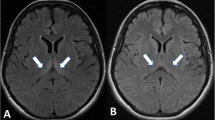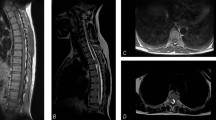Abstract
Chorea gravidarum is uncommon movement disorder of pregnancy, characterized by involuntary, abrupt, non-rhythmic movements. It can be idiopathic or secondary to the underlying pathology. A 28-year-old, primigravida woman who was 8 weeks and 6 days of gestation presented with a history of involuntary choreiform movements in the left side limbs and facial twitch for 2 weeks. The symptoms started just after onset of severe emesis gravidarum. There was no meaningful medical history or family history, and she was taking no regular medication. Magnetic resonance imaging of the brain revealed moyamoya disease. The symptoms, as well as the hyperemesis gravidarum, improved with gestational age; however, they were sustained up to 30 weeks of gestation. She delivered 2.61 kg, healthy male neonate at 40 weeks’ pregnancy by vaginal delivery under epidural analgesia. After 3 years later, she got pregnant again, and delivered at 41 weeks of pregnancy without complication. She experienced similar but milder symptoms to that of the first pregnancy until the late second trimester. After the delivery, full evaluation was lost due to her refusal. In this report, we present the case of a patient with chorea gravidarum in which moyamoya disease acts as an etiologic factor and a review of literature with management proposal.
This is a preview of subscription content, access via your institution
Access options
Subscribe to this journal
Receive 12 print issues and online access
$259.00 per year
only $21.58 per issue
Buy this article
- Purchase on Springer Link
- Instant access to full article PDF
Prices may be subject to local taxes which are calculated during checkout

Similar content being viewed by others
References
Karageyim AY, Kars B, Dansuk R, Aygun E, Unal O, Turan MC . Chorea gravidarum: a case report. J Matern Fetal Neonatal Med 2002; 12: 353–354.
Cardoso F, Vargas AP, Cunningham MCQ, Amaral SV, Guerra AA . Chorea gravidarum: news lessons from an old disease. Neurology 1999; 52: A121.
Takeuchi K, Shimizu K . Hypogenesis of bilateral internal carotid arteries. No T Shinkei 1957; 9: 37–43 (In Japanese).
Chiu D, Shedden P, Bratina P, Grotta JC . Clinical features of moyamoya disease in the United States. Stroke 1998; 29: 1347–1351.
Cardoso F . Chorea gravidarum. Arch Neurol 2002; 59: 868–870.
Oasim A . An unusual case of chorea gravidarum. Postgrad Med J 2000; 76: 374, 378–9.
Fam NP, Chisholm RJ . Chorea in a pregnant woman with rheumatic mitral stenosis. J Cardiol 2003; 19: 719–721.
Donaldson JO . Neurologic emergencies in pregnancy. Obstet Gynecol Clin North Am 1991; 18: 199–212.
Komiyama M, Yasui T, Kitano S, Sasamoto H, Fujitani K, Matsuo S . Moyamoya disease and pregnancy: case report and review of literature. Neurosurgery 1998; 43: 360–368, 368–9.
Spengos K, Tsivgoulis G, Toulas P, Vemmos K, Vassilopoulos D, Spengos M . Hyperventilation-enhanced chorea as a transient ischaemic phenomenon in a patient with moyamoya disease. Eur Neurol 2004; 51: 172–175.
Patterson JF . Treatment of chorea gravidarum with haloperidol. South Med J 1979; 72: 1220–1221.
Komiyama M . Moyamoya disease and pregnancy. J Nucl Med 1999; 40: 214–215.
Sasaki J, Mesaki N . Pregnancy and delivery in a patient with moyamoya disease. Sanka To Fujinka 1984; 1: 109–116 (In Japanese).
Unno S, Iijima M, Osawa M, Uchiyama S, Iwata M . A case of chorea gravidarum with moyamoya disease. Rinsho Shinkeigaku 2000; 40: 378–382 (In Japanese).
Author information
Authors and Affiliations
Corresponding author
Rights and permissions
About this article
Cite this article
Kim, A., Choi, C., Han, C. et al. Consecutive pregnancy with chorea gravidarum associated with moyamoya disease. J Perinatol 29, 317–319 (2009). https://doi.org/10.1038/jp.2008.183
Received:
Revised:
Accepted:
Published:
Issue Date:
DOI: https://doi.org/10.1038/jp.2008.183
Keywords
This article is cited by
-
Differential diagnosis of chorea (guidelines of the German Neurological Society)
Neurological Research and Practice (2023)
-
Antepartum intracranial hemorrhage due to unrecognized unilateral moyamoya disease: a case report
Archives of Gynecology and Obstetrics (2011)



